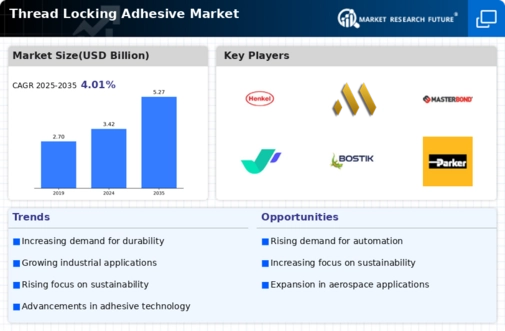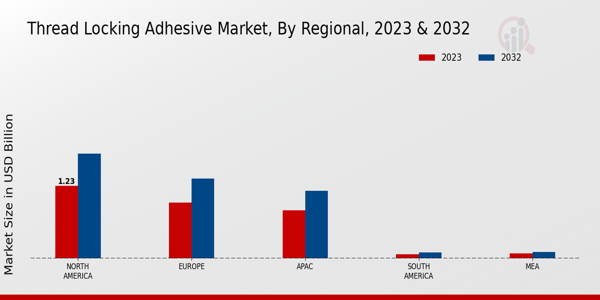Market Growth Projections
The Global Thread Locking Adhesive Market Industry is projected to experience substantial growth, with estimates indicating a market size of 3.42 USD Billion in 2024 and a potential increase to 5.27 USD Billion by 2035. This growth trajectory suggests a compound annual growth rate of 4.02% from 2025 to 2035, reflecting the increasing adoption of thread locking adhesives across various industries. The anticipated growth is driven by factors such as technological advancements, expanding industrial applications, and a rising focus on sustainability. These projections underscore the market's resilience and adaptability in meeting the evolving needs of diverse sectors.
Growing Demand in Automotive Sector
The Global Thread Locking Adhesive Market Industry experiences a notable surge in demand from the automotive sector, which is increasingly adopting advanced fastening solutions. As vehicles become more complex, the need for reliable and durable assembly methods intensifies. Thread locking adhesives provide enhanced vibration resistance and prevent loosening of fasteners, thereby improving vehicle safety and performance. In 2024, the market is projected to reach 3.42 USD Billion, driven by innovations in automotive design and manufacturing processes. This trend is expected to continue, with the automotive industry playing a pivotal role in shaping the future of the Global Thread Locking Adhesive Market.
Expansion in Industrial Applications
The Global Thread Locking Adhesive Market Industry is witnessing significant growth due to its expanding applications across various industrial sectors. Industries such as aerospace, electronics, and machinery increasingly rely on thread locking adhesives to ensure the integrity of assemblies under challenging conditions. These adhesives offer superior bonding capabilities, which are essential for maintaining operational efficiency and safety. As industries evolve and demand more robust fastening solutions, the market is anticipated to grow steadily. The projected compound annual growth rate of 4.02% from 2025 to 2035 indicates a sustained interest in these products, highlighting their critical role in modern manufacturing.
Rising Focus on Sustainable Practices
The Global Thread Locking Adhesive Market Industry is increasingly influenced by a rising focus on sustainable practices within manufacturing processes. Companies are actively seeking eco-friendly adhesive solutions that minimize environmental impact while maintaining performance standards. This shift towards sustainability is prompting manufacturers to develop thread locking adhesives with lower volatile organic compounds and recyclable packaging. As regulatory frameworks tighten and consumer awareness grows, the demand for sustainable adhesive options is expected to rise. This trend not only aligns with global sustainability goals but also positions the market for future growth as industries adapt to changing consumer preferences.
Increasing Investment in Research and Development
Investment in research and development is a critical driver for the Global Thread Locking Adhesive Market Industry. Companies are allocating resources to innovate and enhance adhesive technologies, aiming to meet the diverse needs of various sectors. This focus on R&D leads to the introduction of new products with improved performance characteristics, such as enhanced bonding strength and resistance to extreme conditions. As industries evolve and demand more specialized solutions, the emphasis on R&D is likely to accelerate market growth. The continuous influx of innovative products will not only cater to existing demands but also open new avenues for application, further expanding the market landscape.
Technological Advancements in Adhesive Formulations
Technological advancements in adhesive formulations significantly influence the Global Thread Locking Adhesive Market Industry. Innovations in chemical compositions lead to the development of adhesives that offer enhanced performance characteristics, such as improved temperature resistance and faster curing times. These advancements cater to the evolving needs of various sectors, including automotive and aerospace, where reliability is paramount. As manufacturers seek to optimize production processes and reduce downtime, the demand for high-performance thread locking adhesives is likely to increase. This trend suggests a promising future for the market, with the potential for reaching 5.27 USD Billion by 2035 as new formulations emerge.













